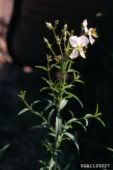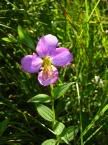

Scientific Name
Rhexia mariana
Uses of Maryland Meadowbeauty: Landscaping, Medicinal, Culinary, etc...
This plant is used mainly for landscape beautification. It has potential for use in cultivated, garden situations, in naturalized prairie or meadow plantings, and along roadsides.
General Characteristics
Melastomataceae Family: An upright (up to 2.5 feet), hairy perennial that frequently spreads to form large colonies. It is native to the U.S. The opposite leaves are elongated, three-nerved, with toothed margins. The pink to lavender or occasionally white flowers are produced from May to October in small clusters near the top of the plant. Each flower is 1-2 inches in diameter and contains 4 petals; the yellow to orange anthers in the center are elongated and curved downwards. The tiny tan to brownish seeds are held in a reddish urn-shaped capsule.
Required Growing Conditions
Meadow beauty grows best in a sunny exposure. It is adapted to heavy textured and to highly organic soils. Natural stands are usually found on moist to wet sites such as in ditches, marshes, and wet meadows.
Maryland meadow beauty is distributed primarily throughout the East and lower Midwest.
Cultivation and Care
A clean, firm seedbed is essential. The site should be treated with a herbicide to control vegetation, tilled, culti-packed once or twice, and allowed to settle thoroughly before sowing.Broadcast 0.5-1 gram seed per 100 square feet (0.5-1 lb/acre). The seed can be mixed with sand or rice hulls to increase volume so that it will be easier to spread uniformly over the planting site. The seed must remain on the soil surface because it is easily smothered when buried in the soil. Heavy rains after planting may cause the seed to be buried or washed from the site.
Status
Several states consider this species threatened or endangered.
General Upkeep and Control
Apply fertilizer according to soil test recommendations. If not available, a rate of 3.5-5.5 oz per 100 square feet (100-150 lb/acre) of 13-13-13 should be applied after the seedlings are established and annually thereafter. If necessary, stands can be mowed in the spring before stem elongation begins. Later mowings should be delayed until the plants have set seed.





0 comments: